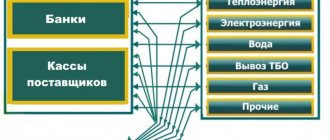Sometimes just paying off your mortgage isn't enough. FAN found out from specialists from the press service of Sberbank (Sberbank of Russia) how to properly remove the encumbrance from a mortgaged apartment.
Mortgage programs, widely available in Russian banks, are often the only opportunity for many people to finally acquire their own home. And now the difficult path from making a down payment, collecting the necessary documents, concluding an agreement and conducting a transaction until the full repayment of the existing debt has been completed, and you become the legal owners of the square meters that have already become yours. The last stage remains - removing the encumbrance from the apartment.
Unfortunately, full payment of the debt does not always equal the removal of the encumbrance. In some banks, this procedure has been simplified as much as possible and made as convenient and understandable for clients as possible; in others, some effort will have to be made to finalize the process, but in any case, all the conditions are quite feasible, and this must be done to put an end to your mortgage “case.” " We will figure out how, in which department and within what time frame the encumbrance on the property is removed, as well as what documents are needed for this.
What is an encumbrance?
An apartment purchased with a mortgage is the property of the buyer, but the agreement imposes certain restrictions on its use, which are regulated by the provisions of the Civil Code of the Russian Federation, Federal Law No. 102 and the relevant clauses specified in the agreement between the financial institution and the borrower.
Not a single bank is engaged in charity, and all its actions are justifiably aimed at obtaining benefits. As a rule, mortgage loans are taken out for a fairly long period, and even the most reliable client with a stable high income and an impeccable credit history may one day, for one reason or another, lose his income, become seriously ill or die, respectively, losing the ability to regularly make monthly mortgage payments. In order, as they say, to remain in its interests, the bank insures itself with collateral (usually this is the very object being purchased or other real estate owned by the debtor). If he stops paying, the collateral is seized and sold.
It is clear that the safety of the apartment is entirely in the interests of the bank, therefore the mortgage agreement contains provisions such as, for example, a ban on redevelopment. In addition, the owner has every right to live in the living space, which is pledged, but at the same time cannot sell, donate, rent it out, or even register strangers who are not members of the family there without the bank’s consent. Before signing the contract, it is recommended to carefully study the relevant clauses in order to avoid possible troubles in the future.
The encumbrance on the apartment must be registered in the Rosreestr database. It can be withdrawn only when all financial obligations to the bank are fully repaid, including interest, regardless of whether this is done exactly on schedule or ahead of schedule.
Once the final payment has been made, it is time to begin the process of paying off the garnishment record. To do this, the mortgagor or a bank representative submits an application and a mortgage note to the relevant authorities. Sometimes it happens that when calculating the final amount sufficient to pay off the existing debt, errors are made, and fines and penalties are charged on the unaccounted balance. Therefore, it is important to obtain a certificate of no debt from the bank and provide it upon request.
According to the law, the period for removing the encumbrance is three working days if the documents were submitted to Rosreestr. When processing the procedure through multifunctional centers, the waiting time may be slightly increased.
pixabay.com/
Preferential categories of citizens. Who can take advantage of a preferential mortgage?
Who is eligible for a mortgage with state support? Since 2021, the Family Mortgage program has been in effect, which gives families the opportunity to take out a loan with a preferential interest rate. The condition for participation is the birth of a child in the family (initially the second, from July 2021 the first) after January 1, 2021. The program was recently extended until 2024. By taking advantage of it, families have the opportunity to take out a mortgage at 6%. The down payment is 15% of the cost of housing, and the maximum loan size depends on the region. A proposal is now being considered to expand the program to secondary housing - but for those cities where there are few new buildings.
In addition, families with children can use the payments to pay off the loan. The rules for repaying a mortgage with maternity capital can be clarified at the bank where the loan was issued.
How to remove an encumbrance
Many people believe that as soon as the last payment is made, all obligations are automatically removed from them. However, this is not always the case.
Some banks really try to protect their clients from unnecessary hassle and do most of the work for them. For example, the press service of Sberbank told FAN that two days after the final repayment of the mortgage loan, clients receive a message that the procedure for removing the encumbrance has begun against them.
After this, there is no need to go anywhere on your own. The bank’s specialists themselves will collect all the necessary documents and submit them to the department. The client receives notifications at each stage of the encumbrance removal process and can track progress in his personal account. As soon as Rosreestr removes the encumbrance, the bank will notify the client about it.
In addition, the client can order an extract from the Unified State Register of Real Estate from the MFC to find out whether the encumbrance has been removed and to make sure that from now on the owner has the right to dispose of the property at his own discretion.
If you do not find a clause in the agreement with the financial institution that its representatives undertake to take care of all the final steps of the mortgage “story,” you will probably need to do everything yourself.
So, to begin the process of removing the encumbrance, you will need to provide the following documents:
- Passports of each of the owners of the property that was previously mortgaged.
- An application in the established form indicating the full name, passport details, place of residence, reasons why the encumbrance is being lifted, real estate that was listed as collateral with the exact address, cadastral number, area. The borrower will be given a stamped form by the bank. If there is more than one owner, then the form is filled out for each of them.
- In some cases, instead of an application, a mortgage certified by the bank (if available) with a note indicating full repayment of the debt is accepted.
- A certificate from the bank confirming the fulfillment of obligations to repay the mortgage in full. There is no single standard for it. Strictly speaking, it is advisable to receive this kind of document after making the last payment on any loan, not just a mortgage. This is necessary in order to avoid possible claims in the future if, for example, the Credit History Bureau did not receive information that the loan was repaid, and it turns out that a conscientious citizen who has paid off his obligations becomes a malicious defaulter. , which can lead to unpleasant consequences.
- Mortgage agreement.
- Contract of sale.
- If maternity capital funds were used to repay the mortgage, a copy of the certificate will be required.
- Receipt for payment of state duty. An extract from the Unified State Register of Real Estate can be obtained both in paper and electronic form, having paid the appropriate fee. The state duty is taken from each owner.
pixabay.com/
The main provisions of the law “On Mortgage” and their brief description
The mortgage sector is regulated by the Federal Law “On Mortgage (Pledge of Real Estate)” dated July 16, 1998. If you want to thoroughly study the mortgage rules, the information is contained there.
Here are the key points that are postulated by this law:
- A variety of property can be pledged under a mortgage agreement: land plots, enterprises, residential buildings, apartments (parts of apartments and residential buildings), garden houses, garages. And also: aircraft and sea vessels and parking spaces.
- The mortgagor (that is, the one who pays the mortgage) may be the debtor himself or a third party. In this case, the property in question remains in the possession and use of the mortgagor.
- The mortgage agreement is drawn up in writing and is subject to state registration (Article 10 of the Law “On Mortgage (Pledge of Real Estate)”). At the same time, a mortgage agreement does not require state registration if it was concluded after July 1, 2014, while the mortgage as an encumbrance is subject to registration.
- The mortgage agreement must indicate the subject of the mortgage, its valuation, the essence, size and period of fulfillment of the obligation secured by the mortgage.
- When concluding a mortgage agreement, the mortgagor is obliged to warn the mortgagee in writing about all the rights of third parties to the subject of the mortgage known to him at the time of state registration (rights of pledge, lifelong use, lease, easements and other rights).
- The mortgagor can and is even obliged to carry out cosmetic and major repairs to the home, unless otherwise provided by the contract. That is, you can change everything in a mortgaged apartment at your own discretion (of course, without violating the law, that is, making unapproved redevelopment is prohibited; however, this is also prohibited for apartments not encumbered with a mortgage).
- The mortgagor may use the property encumbered with a mortgage in accordance with its intended purpose. At the same time, it should not deteriorate the condition of the property beyond the indicators that fit into the concept of “normal wear and tear.” That is, it is obvious that after 10 years, an apartment without renovation will not look the same as on the day the mortgage agreement was concluded, but the resident cannot cause direct damage by worsening its appearance.
- If the mortgagor does not treat the property well enough (that is, commits or allows actions that significantly affect its safety, value and appearance), the mortgagee may demand that the mortgage obligations be fulfilled ahead of schedule.
- The risk of loss or damage to property is borne by the person taking the loan. If he did not sufficiently prevent possible damage (he did not insure the apartment, did not make repairs on time, used faulty equipment, and so on), he may be required to fulfill his mortgage obligations ahead of schedule.
- A mortgaged apartment can be sold and given as a gift, unless otherwise specified in the contract. Obligations under the mortgage are transferred to the person who becomes the new owner.
- The law establishes the concept of a subsequent mortgage - that is, an apartment that is pledged can be collateral for another loan obligation, unless otherwise provided by the agreement. The mortgagee must be aware of this.
- The mortgagee can “assign” the mortgage to a third party, who receives all of his rights and obligations.
- If the person who took out the loan cannot repay it, the property pledged as collateral may be seized from him in order to pay off the debt to the bank.
Removal of encumbrance on the Rosreestr website
If the pledgor has the right to electronic digital signature, there is no need to go anywhere at all. Just go to the Rosreestr website in the “Electronic Services” section and open the “State registration of rights” tab, inside of which there is the item “Repayment of a mortgage registration record.” Next, you will need to fill out information about the property, enter your data and attach scans of the required documents. A message about the completion of the procedure will be sent to the specified email address.
Possible reasons for refusal
It also happens that instead of the long-awaited notification of the removal of the encumbrance, a refusal comes. The reasons for this may lie in the following:
- Incomplete set of documents.
- Not all owners provided the necessary documents.
- There was a technical glitch and the borrower still owes on the mortgage.
- The application can only be submitted by the owner in person. If this is not possible, it is necessary to issue a notarized power of attorney to another person.
- Errors in documents, including spelling errors. Check everything carefully before shipping.
pixabay.com/
Removing a mortgage encumbrance is not as complicated a procedure as it might seem at first glance. Experts recommend that after making the last payment, for your own peace of mind, take an extract from the Unified State Register from the MFC to once again make sure that the property is now at your complete disposal.
Features of mortgages with land plots
A mortgage on a land plot assumes that the collateral is not real estate, but land. It is important to understand that any contracts in this case apply to the land plot. If the borrower needs to build real estate on the site using mortgage funds, this must be a separate loan with an independent payment schedule and separate conditions.
You can take out a mortgage on land for the construction of a residential building, a garden house, or for organizing a personal household. Each bank has its own requirements that must be met by the land plots for which they will provide a loan. For example, banks may require that the plots have established boundaries, are not located in environmental protection and reserve zones, and have communications nearby. There may be size restrictions and so on. All specific rules for applying for a mortgage on land should be found out in the bank where the loan is supposed to be issued.











